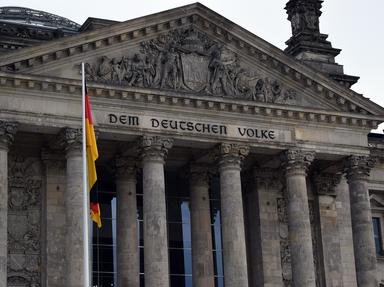Quiz Answer Key and Fun Facts
1. La Tene culture in southwestern Germany flourished between the Iron Age and Roman conquest of German lands. It pre-dated the arrival of Germanic tribes and featured a culture now more linked to pre-Saxon cultures of the British Isles. Which language group was most widely found in Germany's La Tene culture sites?
2. By the 1300s, a league of trading cities, led by Lübeck, included northern German towns like Bremen, Köln, Rostock, and Berlin, as well as such cities of today outside of Germany, like Szczecin (Stettin), Gdansk (Danzig), Novgorod, Riga, and Talinn (Reval). What was the name of this league?
3. In the 12th and 13th centuries a number of German poet-musicians appeared who sang songs of courtly love. Mostly members of the lower nobility, they often composed their own words and music. By what name were these German "troubadours" known?
4. Who is widely regarded as the greatest artist of the German Renaissance?
5. In A.D. 800, Pope Leo III crowned Charlemagne "emperor," upgrading his status from king. Prior to his new title, of what Germanic tribe was Charles the Great (Karl der Große in German) known as King?
6. In 1356 the German Imperial Diet issued the Golden Bull. It specifically concerned the Archbishops of Mainz, Cologne, and Trier, as well as the King of Bohemia, the Margrave of Brandenburg, the Duke of Saxony, and the Count Palatine of the Rhine. With what power did the Golden Bull endow them?
7. In A.D. 9 a German Cherusci chief named Hermann, who had been trained in the Roman Legions as Arminius, led a coalition of German tribes to defeat three full legions in a battle in the Teutoburg Forest in just one day, September 9. As a result of this Hermannsschlacht, what was established as a permanent boundary between Roman lands and German lands?
8. The Bohemian Revolt (1618-1621) was one of the events leading into the Thirty Years War, which had a devastating effect on the German states. What event precipitated the Bohemian Revolt?
9. We all know that Napoleon's final defeat came at Waterloo in 1815. But two years earlier, in a battle called the Battle of Nations because of its size and number of troops that took part, a Napoleonic defeat marked the end of the French Empire east of the Rhine. Where in Germany did this battle take place that featured a total of 600,000 troops on both sides combined, compared to 140,000 at Waterloo?
10. The Schmalkaldic League was an alliance of Protestant German princes who fought against Emperor Charles V for the right to maintain Protestantism in their lands. A short war (from 1546 to 1547) was resolved in 1555 with a treaty that granted individual princes within the Holy Roman Empire the right to select either Protestantism or Catholicism for the lands that they ruled. Where was this treaty signed?
Source: Author
shvdotr
This quiz was reviewed by FunTrivia editor
bloomsby before going online.
Any errors found in FunTrivia content are routinely corrected through our feedback system.

